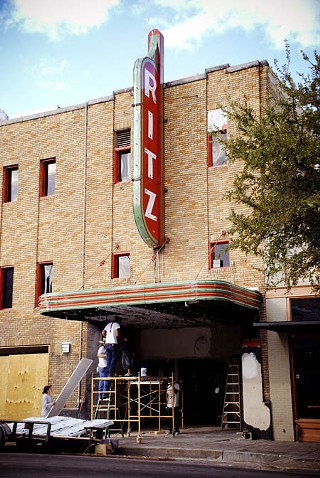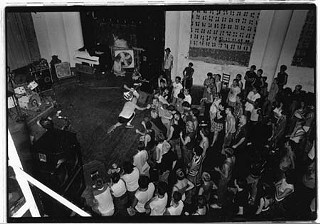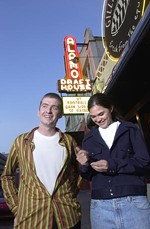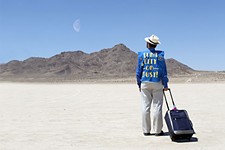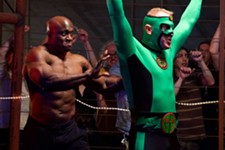Re-Re-Re-Re-Reopening Night
The Ritz: talkie theatre, cowboy hangout, playhouse, comedy and punk club, Alamo Drafthouse Cinema
By Marc Savlov, Fri., Nov. 2, 2007
It's 7am, seven days before Día de los Muertos, and 320 E. Sixth is full of ghosts. It's chilly curbside but gorgeous, too, the merc barely blowing past 40, the Austin fall in all its skyscraping, crystal-blue splendor, the Frost Bank Tower looking truly frosty, the burnt-out ruin of the Black Cat Lounge looking deader than RKO Radio Pictures.
The massive fire-engine-red-and-white sign bracketed flush to the ancient maroon brick facade hollers out "The Ritz" loud enough to knock the shade of Tex Ritter off his trusty stallion, White Flash, but right here, right now, there isn't any Trouble in Texas for the singing cowboy to get into or out of, other than the fact that in one week, the Alamo Drafthouse at the Ritz is going to open the double doors to its double screens for the very first time, and while the terraced seats are mounted, the angled tabling upright and awaiting the first of an infinite number of Shiner Bock wipeouts to come, there's still only one screen – the little one – up and unfurled, and the only thing in the dual-facing projection booth is drywall dust and some guy named Moe. Or Joe. Or José. It doesn't matter. Whoever he is, he isn't Tim or Karrie League, the husband-and-wife founders of the Alamo Drafthouse Cinemas, of which this particular venue will be the new, justifiably awesome flagship.
They're probably still catching some increasingly rare and well-deserved shuteye. And why not? If six days was enough time to create all of existence, then surely the Alamo Ritz is gonna be a snap to whip into shape in seven.
After all, the ghosts are already here. They've been queuing up for the past 78 years, in fact, cosmic cowboys and Indians, Vincent Price and Gamera, Glenn Danzig, Ian MacKaye, and Esther's Follies, all, at one point or another, under the same sagging roof, on the same, ever-changing block, for 78 years and counting.
A Brief History of the Ritz, or, Leonard Nimoy Meets Minor Threat
"The Ritz opened two weeks before the stock market crashed in 1929," explains Judge Larry J. Craddock, whose family owns the property the new Alamo and the old Ritz are situated on. "It turned out to be a wonderful Depression-type of business because people still wanted entertainment, and it was the first theatre in Austin to be built for sound movies."
Craddock's grandfather, L.L. Hegman, built the Ritz, just one of several movie houses he owned in Austin (others included the Queen on Congress Avenue, directly across from what was then the Majestic, now the Paramount), specifically to take advantage of the then-new talking-picture craze. Since then, the theatre has lasted both as part of the Hegman/Craddock family and as a Downtown landmark, stolidly refusing to either become gentrified or fall into outright ruin. The Ritz theatre saw not only the rise and fall of the B-movie Western fare that Hegman's exhibition hall first showcased but also, under the helm of L.L.'s son Elmo and Jenny Hegman, the great MGM musicals, Roger Corman's Sixties-era American International Pictures, and assorted Tokyo-stomping Godzilla outings.
But back in the early days, "It was the height of the B-movie Westerns," Craddock says, "and a lot of the cowboy stars would come to town and put on a show at the theatre, twirling their lassos on the stage and talking to the kids who came to the Saturday matinee.
"Austin used to have blue laws stipulating that you couldn't open theatres on Sundays, and one of my grandfather's chief claims to fame was doing just that. So when the police didn't have anything better to do on a Sunday, they'd go over to the theatre and arrest my grandfather and my grandmother for showing movies on Sunday."
Apocryphal stories from reliable sources tell semitall tales of cowboys running amok in the aisles, but the Alamo's Tim League tells it best:
"The Ritz was never a 'nice' theatre, per se. It was never very opulent; it was kind of a working-class theatre, never very high on design. But back in the Thirties, when Sixth Street was a crazy, wild place, it was known as the 'Western' theatre and actual cowboys would come in, a lot of whom had never seen a movie before. They'd get freaked out, liquored up and loving it, and end up pulling out their six-shooters and shooting at the screen! The Ritz screen was riddled with holes from drunk cowboys."
In 1937, L.L. passed the Ritz to son Elmo, who then ran the theatre as both a first-run and second-tier outfit until business slowly dropped off and the Ritz was shuttered as a functioning cinema, officially, in 1964. But this being Austin, that's really just the first chapter in Ritz history. Ask any cosmic cowpoke you can find about what happened next, and you'll get an earful of Armadillos. In particular, Austin's legendary artist and Threadgill's fixture Jim Franklin, who along with Bill Livinggood reopened the Ritz in 1974 (after it suffered the requisite stint as a XXX, bump 'n' grind house in the early Seventies) as something of an extension of Eddie Wilson's Armadillo World Headquarters. Franklin took to living in the cramped projectionist's booth during what was to be only a yearlong tenure that nonetheless saw top-draw performances from the likes of Willie Nelson and other AHQ staples, as well as stage plays, including Tennessee Williams' Small Craft Warnings. Even Leonard Nimoy showed up. Still, Franklin's Ritz failed to live long or prosper, although it remains, despite its brevity, one of the Ritz's most warmly recalled incarnations.
In 1975 Franklin and company moved out and onward through the fog. By this time, the interior of L.L. Hegman's theatre had become a moth-eaten, soda-stained, flypaper-floored, popcorn-and-pot-reeking pit of dark, dank funlessness. Rumor had it that there were things (possibly Jujubes gone wrong) growing on the undersides of the theatre seats that took a Texas chain saw to Steven McQueen's Blob. And what better place to put Austin's exploding punk rock scene? Or, for that matter, the expanding audience of Austin vaudevillians Esther's Follies?
In January 1982, the Ritz was reborn under the management of Craig Underwood and Esther's Follies husband-and-wife lease-holders Shannon Sedwick and Michael Shelton.
"The first thing we did," recalls Sedwick, "was Greater Tuna in February '82, and then we showed films. We had Austin Journegen's TV Ranch, John Waters; Stevie Ray Vaughan played, and then in '82 through '84 we had the punk rock shows – Raul's was still open, but since the Ritz was a larger venue, we got the bigger names ... Megadeth, the Red Hot Chili Peppers, Slayer, and the Big Boys were regulars."
Saturday, May 8, 1982, was a landmark day for Austin's punk scene: The inaugural Ritz punk bill, featuring SST Records godheads Black Flag, Saccharine Trust, and locals the Big Boys and the Dicks, was just the first of many experiments in high-decible chaos and Lone Star-fueled myth-making. (For Underwood's complete story on the historic night, see www.leftofthedialmag.com/?p=332.) With punk nexus Raul's club, which was up on the Drag where the Texas Showdown now resides, on the way out, the Austin punk scene had the air of an orphaned stray, but at the Ritz it found a place it could call home, if only for a while. Underwood, Sedwick, and Shelton brought in the biggest and the best punk legends of the time, among them the Misfits, Minor Threat, and Hüsker Dü, and later provided a breeding ground for homegrown groups like Scratch Acid and Agony Column, as well as both local and national bands from the emerging speed-metal genre, not least of which was Jason McMaster's Watchtower.
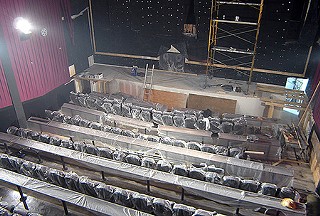
Photo courtesy of Alamo Drafthouse
In October 1983, the original Esther's location burned down, precipitating a move of the entire show to the Ritz. Some of the more audience-intimate aspects of Esther's Follies were lost in the Ritz's cavernous hall, which, as Michael Shelton recalls, still made for some bizarre lobby encounters as the marginally more reserved Follies crowd let out at 10pm just as the 'hawks and skins began to enter for their Ritz experience.
Punk's tenure at the Ritz was relatively short, sharp, shocking, and predictably rocky, with both beer and blood flowing down theatre aisles and pooling in the pit before the 5-foot-high Doc Martens-scuffed stage. It was hardcore heaven down there for a few years, scabby knees skanking counter-clockwise, clenched fists, black eyes, loudfastrules, maximum rock & roll, the works. It didn't last long, but it did last longer than most nonfilmic Ritz ventures – three summers in all – until the weekly dustups between the punks and the frats became dusty enough for then-Police Chief Frank Dyson to take personal notice – in the midst of a Butthole Surfers performance, no less – and thus shut off the Ritz's mohawk valve in perpetuity, in the summer of 1984.
Shelton: "At the time, putting on those punk shows were sort of a pain, but in later years we realized, wow, those were some incredibly classic bands. It was quite a scene. But with that slanted floor in there, if somebody would drop a bottle of Lone Star, that thing would roll all the way to the front. It was very distracting trying to do theatre in there."
In February 1987, Esther's moved on to 501 E. Sixth (now Coyote Ugly), and after that, the Ritz followed the fortunes of Sixth Street, most notably coming under the aegis of both the late Paul Sessums of the Black Cat Lounge and, in the Nineties through 2005, local bar maven Bob Woody, who eventually removed the theatre's seating and overhauled the entire premises into a successful bar and game room that saw as much punk rock overflow as Emo's could spit out on any given night, with live music and performances – including Cinemaker Co-op precursor Bill Daniel's Funhouse Cinema series – upstairs in the Ritz Lounge.
And that, as they say, was that. Until now.
The Last Night of the Alamo, the First Night of the Ritz
It's two weeks before opening day of the Alamo Drafthouse at the Ritz, and I'm sitting in the back of Shakespeare's Pub with Tim League and Alamo programmer Lars Nilsen's hair. Sawdust from the construction work at the Ritz – mere feet away and separated by only a brick wall and some urban flora that might be triffids, could be ivy – is drifting into my Shiner Bock and gumming up my contacts. Sneezes abound on the site and commingle with all of the other building sites cropping up all over the Downtown Austin footprint. But the Alamo at the Ritz? Take a Benadryl, and bite down hard – it's gonna be worth it. They've even installed walls within walls within walls to snafu Sixth Street's year-round, Phil Spectorian cannonade of sternum-rattling sound.
Tim League explains how it all went down: "Back like a year ago, [Alamo management] had started trying to figure out ways that we could stay [at the 409 Colorado address] at, what was for us, an inordinate amount of money. We were tossing around a nonprofit idea at one point, we had a membership program, and we were determined to make this work somehow. At the same time we were evaluating other options, but nothing was really working for what we wanted to do with Downtown. And we really, really wanted to keep the same feeling as what we had at the original Alamo."
Enter Molly Alexander of the Downtown Austin Alliance.

League continues: "At what was literally the very last minute before we had to sign the lease on the Colorado location, Molly showed up with the idea of moving us into the Ritz. She had come to us once before and tried to get us into the Hard Rock Cafe building, but the space wasn't right for our needs.
"This time she had approached Larry Craddock of the Ritz, he liked her idea, we met with him, and he ended up committed to giving us a really good lease rate on the property. Luckily for us, Judge Craddock wanted to see the theatre return to being something that was good for the street and back to what he remembered from his childhood. Long story short, we basically bought out the lease on the Ritz Lounge for the rest of its duration in a deal that was separate from Larry, which then made us a tenant of the Ritz, and then we signed a new Ritz Theatre lease with him. Does that make sense?"
Only to you, Tim, but it's enough to know the good guys (and the stars) are, for once, perfectly aligned. And how has construction been going so far? Can you make the Nov. 1 grand-opening deadline? What's the worst that's happened in terms of renovating a building erected in 1929?
"We had, literally, the oldest water line in Austin behind us in the alley north of Sixth Street. That was an unexpected problem. It's been functional since circa 1910, and it was crazy because none of the buildings on this block have any sort of sprinkler protection. We had to dig a trench all the way to Trinity. It ended up costing us $100,000 for that one thing, which we budgeted $3,000 for."
And the best part, so far?
"Relocating the original Alamo into the historic Ritz is pretty much a dream come true for us – it all just kind of fell into place. Once it did, it just seemed so right, you know? The Alamo Village was a Seventies theatre; the Alamo Lake Creek was an Eighties theatre; the original Alamo Downtown was a warehouse. I mean, I love old theatres, and I'd never had the chance to move into one since our Bakersfield days. Even though, financially, Bakersfield was a disaster, the actual running of an old-time theatre has always been something I missed."
Talking about the Ritz, League is painfully sincere (and, as the project's 24/7 general contractor, sore as hell, to boot), and it's impossible to not feel a swell of pride in everything he and his wife, Karrie, and their whole DIY, do-or-die crew have accomplished not only in the past six months since breaking ground on Sixth Street but over the decade, since they first opened that little, sweaty, sawdust-strewn rat-hole of a film-lover's paradise at 409 Colorado. Wherever it goes, long may it reign.
Lars' hair? Would you like the parting, feel-good, magic-hour martini shot?
"Some places just have a particular sort of feeling," says the actual Nilsen, from beneath his legendary mane. "You just walk on in, and there's a ready-made special-cool vibe.
"The Downtown Alamo felt like a parking garage for the first few years when I was going as a customer, but when you walk into the Ritz, you get the feeling that that specialness is already here. And, really, we're just picking up a baton that's passed through a lot of hands over a long period of time.
"This is a very special thing that's happening here, you know? And I think that, in the same way that the opening of the original Downtown Alamo was kind of a turning point for the Fourth Street area, this could do the same for Sixth Street. Look at how much there is to build on – the amazing old buildings, the amazing old walls. Sixth Street doesn't have to be a lame place, and I hope that the Alamo at the Ritz can help make it a little less of the lame shot-bar place that it's occasionally been in danger of becoming. No offense to our neighbors, the shot-bar places!"
I'll drink to that. First round's on you, Tex Ritter.





